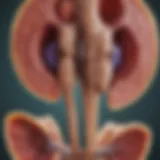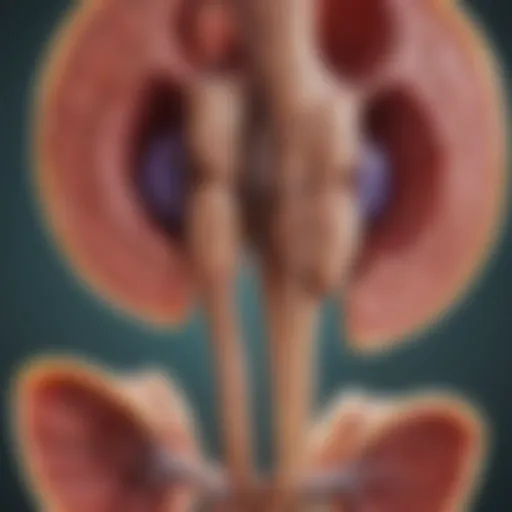The Sucking Louse: Biology, Ecology, and Impact
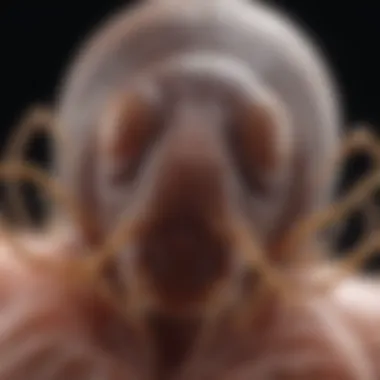

Intro
Sucking lice, often hidden in plain sight, are more than just creepy crawlers that invade our scalps or pets. These parasites play significant roles in the ecosystems they inhabit, influencing host populations and even contributing to disease transmission. An examination of these organisms reveals not just their biological complexity but also their broader ecological implications.
To truly grasp the nature of sucking lice, one must venture beyond simplistic perceptions, acknowledging their evolutionary journey and their adaptations throughout time. This article aims to unravel the intricate relationship between sucking lice and their hosts, shedding light on their life cycles and survival strategies, while also addressing the health risks they pose to both humans and animals.
Preamble to Sucking Lice
Sucking lice, a group of parasitic insects, hold a significant place in the natural world, impacting both human and animal health. These small creatures are often overlooked, yet their presence can tell us a great deal about ecological balance and the interactions between species. Understanding sucking lice is not merely an academic exercise; it illustrates vital concepts of parasitism, co-evolution, and disease transmission, which have important implications in public health and veterinary science.
Understanding Parasitism
At the core of studying sucking lice is an examination of parasitism itself. Parasitism is a biological relationship where one organism benefits at the expense of another. Sucking lice attach themselves to their hosts—humans, mammals, birds—and derive their nourishment by feeding on blood. This strategy enables them to survive, reproduce, and thrive in various environments.
In essence, the relationship between sucking lice and their hosts raises critical questions. How do these parasites decide which host to infect? What physiological changes occur in the host due to the infestation? Moreover, parasitism can influence the evolution of both the louse and its host. For example, as lice adapt to cling better to their hosts, the hosts might evolve defenses—either behavioral or immunological—to counteract these parasites.
By comprehensively grasping parasitism, one can appreciate the complexity of ecological webs and recognize the often subtle dynamics at play in nature. This understanding is not solely academic; it has pragmatic implications for controlling lice infestations in humans and livestock, which remain a public health challenge decades after they've been discovered.
Historical Perspective on Lice Research
Research on lice has a long and storied history, stretching from ancient texts to modern genomics. Early references to lice can be found in Egyptian hieroglyphs dating back thousands of years, indicating that concern over these parasites is not a new phenomenon. The significance of lice in human health was spotlighted in the works of Aristotle, who noted their impact on domestic animals.
The 19th and 20th centuries saw rapid advancements in the study of lice, largely driven by the understanding that they can transmit diseases. For instance, the discovery of the role of body lice in spreading typhus during wartime became a pivotal moment in public health history. Modern studies have delved deeper into lice's biology, ecology, and their role in zoonotic diseases, emphasizing their importance not just for humans but also for our relationship with domestic animals.
"Understanding the historical context of lice research allows us to appreciate how our perceptions of these pests have evolved over time, influencing public health policies and personal hygiene practices."
Today, advances in molecular biology and genetics have provided new tools for examining lice, leading to a fresh understanding of their evolution and adaptability. This historical lens sheds light on our current challenges with sucking lice and points toward future research avenues that may improve management strategies and health outcomes across species.
Taxonomy of Sucking Lice
Understanding the taxonomy of sucking lice is central to grasping their biological significance, especially in terms of evolution and ecology. Taxonomy provides a framework for categorizing the vast diversity of sucking lice, which is essential for researchers and professionals alike. This classification helps in identifying species, understanding their relationships with hosts, and studying their evolutionary pathways. While it may seem like a technical endeavor, knowing where these creatures fit in the insect family tree informs our comprehension of their role in ecosystems and diseases.
Classification within Insecta
Sucking lice belong to the order Phthiraptera, which encompasses various parasitic insects. Within this order, they are classified into two suborders: Anoplura and Mallophaga. Anoplura includes the true sucking lice, while Mallophaga comprises chewing lice that primarily infest birds and mammals but do not feed on blood. This distinction is crucial, as it highlights the differing feeding habits and host relationships—sucking lice latch onto their hosts to extract blood, while chewing lice feed on skin flakes, feathers, and fur.
Major Families and Species
Sucking lice are further divided into two significant families: Pediculidae and Phthiridae. Each family reflects a unique adaptation to their lifestyles and hosts.
Pediculidae
The family Pediculidae is particularly important because it includes some of the best-known human parasites, such as the head louse (Pediculus humanus capitis) and the body louse (Pediculus humanus corporis). One key characteristic of this family is their flat bodies, which make them adept at navigating through hair and clothing. This structural design is not just for show; it helps them remain close to their host and facilitates their feeding habits.
The advantage of focusing on Pediculidae in this article lies in their relevance to public health. These lice are notorious for transmitting various diseases, including typhus and trench fever. Understanding their classification and biology can yield more effective treatment and control strategies.
One unique feature of the genus Pediculus is their complex life cycle. Upon getting on a host, these lice lay eggs, or nits, which attach firmly to hair shafts. This lifecycle detail emphasizes the necessity of diligent personal hygiene and health education.
Phthiridae
On the other hand, Phthiridae includes a variety of species that have a broader host range, mainly affecting birds and some mammals. A notable genus within this family is Goniocotes, known for being a pest of poultry. A significant aspect of Phthiridae is their diversity; some species demonstrate very specific host preferences, while others are more generalist.
A prominent feature of this family is the diverse feeding strategies. They can exploit different resources, adapting to varying ecological contexts. This flexibility plays a vital role in their ongoing survival and proliferation.
The relevance of studying Phthiridae lies in their broader ecological implications. Understanding their interactions with birds and other mammals helps researchers monitor ecosystem health and stability. Moreover, these lice can serve as indicators of environmental changes, which can be crucial information for conservation efforts.
"Taxonomy not only categorizes but narrates the evolutionary story of these insects, revealing insights into their past and potential future."
Morphology and Anatomy
Understanding the morphology and anatomy of sucking lice is not just a matter of academic curiosity; it plays a crucial role in comprehending how these ectoparasites exist, thrive, and affect their hosts. By dissecting their physical structures, we gain insights into their behavior, adaptations, and the ways they interact with their environment. This section aims to demystify their complex anatomy, highlighting important features that facilitate their parasitic lifestyle.
External Features
Body Structure
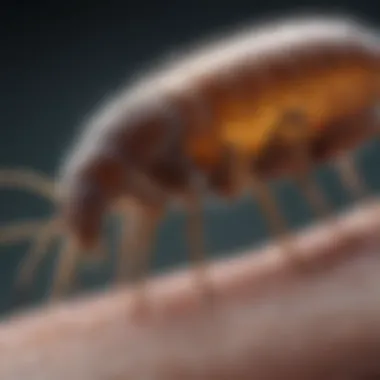

The body structure of sucking lice is uniquely adapted for a life of parasitism. For instance, they possess a flattened body shape that allows them to navigate through the coarse hair or feathers of their hosts. This shape serves two significant purposes: it minimizes the risk of being dislodged while feeding and maximizes surface area for attachment. A key characteristic to note is their segmented body, which consists of the head, thorax, and abdomen. This segmentation helps the louse move easily across its habitat.
One unique feature worth mentioning is the development of a strong, hardened exoskeleton, which not only offers physical protection from external factors but also helps in retaining moisture, a vital aspect considering their dependency on blood for sustenance. However, this does come with its drawbacks; a more rigid body structure limits flexibility and mobility in tight spaces.
Feet and Claws
Turning our attention to the feet and claws, these appendages are specifically designed for gripping the host’s hair or feathers tightly. Unlike many insects, sucking lice have evolved distinctive claws that resemble hooks. This adaptation is a game changer for their survival. The primary characteristic here is their size and strength; the claws are proportionate to their body, ensuring secure attachment.
An interesting aspect of these claws is how they enable the louse to maintain a firm hold even when their host moves or shakes. Still, the unique feature of having two pairs of legs, each equipped with specialized claws, does create a reliance on specific types of hosts. This means that liches are often host-specific, limiting their ability to infest multiple species.
Internal Anatomy
Examining the internal anatomy provides additional depth to our understanding of sucking lice. Their organ systems are finely tuned for a parasitic lifestyle.
Digestive System
The digestive system is particularly fascinating. Sucking lice possess a highly efficient, specialized digestive tract that is optimized for processing blood meals. Notably, their mouthparts are adapted as piercing and sucking structures, allowing them to effectively extract blood from their hosts. The main characteristic here is the presence of a modified proboscis. This allows them to reach deep into the host's skin, enabling them to secure a meal without inflicting significant damage.
A unique feature of their digestive system is the rapid absorption capabilities. Lice can ingest blood and transfer necessary nutrients quickly, ensuring they gain energy for reproduction and growth. However, rapid absorption also leads to a dependency on frequent feeding, making their lifecycle heavily tied to their host's presence.
Nervous System
The nervous system of sucking lice also has distinct characteristics that warrant attention. Comprising a simple series of ganglia, it controls their basic movements, feeding behavior, and responses to environmental factors. A key aspect of their nervous system is its simplicity compared to more complex insects, which allows for quick reactivity to stimuli.
What’s particularly unique here is the louse's ability to detect changes in their environment rapidly, aiding in their survival strategy. Yet, this simplicity can be a double-edged sword; while effective for their lifestyle, it can limit their adaptability to drastic changes in their host environment.
Understanding the anatomy of sucking lice not only sheds light on their life cycle but also provides insights into potential control measures that can be developed based on their biology.
Life Cycle of Sucking Lice
Understanding the life cycle of sucking lice is paramount to grasp the dynamics of these parasitic insects. Each stage in their development is intricately linked to their role as parasites, affecting not only their survival but also their interactions with hosts. Knowing how they reproduce, grow, and mature offers significant insights into effective control measures and understanding their impact on both human and animal health. The life cycle can be an intricate dance, reflecting the harsh realities of parasitism and survival.
Egg Stage
The first phase in the life cycle of sucking lice is the egg stage. Female lice lay eggs, commonly referred to as nits, which are usually glued firmly to the base of the hairs or feathers of their host. These eggs are often oval-shaped and can vary in color, typically white or yellowish, making them challenging to spot.
The importance of this stage lies in its vulnerability. Nits take roughly a week to hatch but are exceptionally resilient. This resilience allows sucking lice to proliferate rapidly when environmental conditions are favorable. Knowing their potential to reproduce quickly is crucial for devising control strategies.
- Egg Characteristics:
- Shape: Ovoid
- Color: White or yellowish
- Attachment: Firmly glued to host
Nymphal Stages
Once they hatch, young lice enter the nymphal stages. Nymphs resemble smaller versions of adult lice, lacking reproductive maturity. These stages typically have three molts before reaching adulthood. Each molt brings a size increase and significant changes in behavior and feeding habits.
During these stages, the nymphs are on a constant hunt for blood meals, which is essential for their growth and transition to adulthood. What’s fascinating is that they also learn to adapt to their hosts, becoming adept at blending in and evading detection. Nymphs can remain with the same host or migrate to new ones, depending on availability and environmental pressures. This adaptability is another reason why control can be challenging.
- Nymphal Stages Features:
- Number of molts: Three
- Size: Incremental growth
- Behavior: Persistent feeding behavior
Adult Characteristics
Upon completion of the nymphal stages, lice reach adulthood. Adult sucking lice are significantly larger than nymphs and possess fully developed reproductive systems. An important aspect of adult lice is their longevity, with some species living for several weeks depending on environmental conditions and host availability.
They exhibit specific adaptations, such as specialized mouthparts for piercing skin and accessing blood vessels, along with claws to cling tightly to hair or feathers. Understanding these traits adds depth to our knowledge of their biology and explains their prowess in survival and reproduction.
- Adult Lice Features:
- Size: Larger than nymphs
- Lifespan: Several weeks
- Mouthparts: Specialized for feeding
"The life cycle of sucking lice not only illustrates their transformation but also highlights their resilience in various environments, making them formidable parasites."
Emphasizing the life cycle of sucking lice sheds light on their evolutionary success as parasites. Acknowledging how each phase of their life contributes to their overall survival and adaptability serves as a foundation for future research and interventions in disease control and prevention.
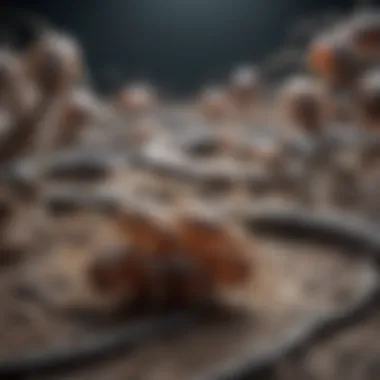

Ecological Roles of Sucking Lice
The ecological roles of sucking lice are multifaceted and significant within the ecosystems they inhabit. While many consider these parasites to be mere nuisances in both human and animal populations, their interactions with hosts and their contributions to ecological balance should not be overlooked. By examining host relationships and their impacts on ecosystems, we can glean insights into the broader implications of sucking lice in nature.
Host Relationships
Specificity to Hosts
Sucking lice show a remarkable degree of specificity to hosts, meaning they often have a preference for a particular type of animal. This characteristic plays an essential role in the life cycles of these parasites. For instance, the Pediculus humanus, which is specifically adapted to humans, displays traits that optimize its ability to feed, reproduce, and thrive on human hosts. This specificity contributes to the overall stability of the host population since lice populations can influence host behavior indirectly. Often, infected individuals may undergo stress, which could affect their survival rates and reproductive success.
An important aspect is the idea of resource utilization. Sucking lice tend to be well-suited to their designated hosts, taking full advantage of the nutritional resources provided through the blood of their specific dwellers. However, this specialization can also lead to vulnerabilities, as changes to the host's environment can drastically affect lice survival, making their population dynamics somewhat precarious.
Although specificity allows for a more robust relationship between lice and their hosts, it can also create challenges for lice. For example, should a host species face severe population decline or habitat loss, their specialized lice might suffer consequential effects, potentially leading to their extinction. This duality—of having benefits and drawbacks related to specific host relationships—highlights its importance in the study of sucking lice.
Co-Evolution with Hosts
The co-evolution with hosts is a fascinating aspect of the relationship between sucking lice and their respective animals. This evolutionary dance refers to how parasites and hosts influence each other's adaptations over time. Sucking lice have developed several mechanisms that allow them to thrive specifically within their host environments, such as specialized mouthparts that precisely grip the host to minimize danger while feeding.
On the other hand, hosts often evolve defense mechanisms against lice. Over time, this mutual influence encourages innovation on both sides— lice evolve to enhance their feeding efficiency and survivability, while hosts develop immune responses to fight off infestations. This interplay is crucial for understanding how ecosystems maintain balances.
A notable feature of this co-evolution is how it shapes genetic diversity within both lice and their hosts. The adaptations fostered by co-evolution can lead to significant genetic variation, enhancing resilience within both populations. In turn, this can help them adapt more readily to environmental changes. Yet, this delicate balance can shift, leading to population outbreaks or collapses in one group, causing ripple effects throughout their ecosystem.
Impact on Ecosystems
Now, when considering the impact on ecosystems, sucking lice might seem like small players in the grand scheme of things, but their roles are surprisingly profound. Their presence can modulate host populations and influence community structures. For example, high infestation levels can weaken fish or mammal populations, impacting predator-prey dynamics as weakened individuals become more susceptible to predation.
Additionally, lice serve as biological indicators of host health, environmental stressors, or ecosystem alterations. Changes in lice populations can signal shifts in host habitats or changes in climate, drawing attention to larger ecological concerns. This information is invaluable for wildlife managers and conservationists aiming to maintain balance within ecosystems.
"Understanding the ecological roles of sucking lice not only helps in their management but also offers insights into the health of associated wildlife populations, resonating with the larger themes of ecosystem dynamics."
From the perspective of human health, these ecological roles gain additional significance. As we look into human-sucking louse interactions, whether they be head lice in children or body lice as signifiers of poor hygiene, their ecological roles reflect broader societal issues, including access to healthcare and public awareness. Overall, a comprehensive understanding of sucking lice provides a unique glimpse into the intricate webs of life and relationships in ecosystems—both wild and domestic.
Sucking Lice and Disease Transmission
The connection between sucking lice and disease transmission cannot be understated. These parasites not only cause discomfort and irritation to their hosts, but they also serve as vectors for various pathogens. Understanding this relationship is crucial, especially for public health officials and veterinarians alike. By examining the roles that lice play in the transmission of diseases, we can better manage their impact on both human and animal populations. The implications of lice-borne diseases stretch beyond individual cases of infestations; they challenge entire communities and livestock industries.
Human Diseases Associated with Lice
Lice-borne Pathogens
Lice-borne pathogens represent a significant concern in the study of these parasites. The lice, when they feed on their hosts, can acquire pathogens from blood and subsequently transmit these to new hosts. One notable example is the bacterium Borrelia recurrentis, which causes relapsing fever. The transmission usually occurs when lice feces are scratched into the skin, or through direct bite wounds.
This type of pathogen is particularly insidious. Not only do lice aggravate skin irritation, but they also can facilitate severe systemic infections that can lead to life-threatening situations. The adaptability of lice to carry and spread these pathogens makes them particularly difficult to manage. Their small sizes and rapid reproductive cycles further contribute to their capacity for disease transmission, which is crucial for any analysis of public health measures.
Public Health Concerns
Public health concerns regarding lice and their associated diseases are profound. The resurgence of lice infestations in some regions correlates with outbreaks of diseases, highlighting the need for comprehensive surveillance strategies. Lice have been implicated in the spread of other illnesses like typhus, again pointing out how interwoven their role is with broader public health issues.
The key characteristic of these public health concerns is their expansive implications. Beyond just health, they affect economic stability, particularly in areas prone to outbreaks. A unique feature of lice-related diseases entails their impact on vulnerable populations such as children in crowded conditions. These settings make for fertile grounds for both lice and communicable diseases, further stressing the importance of effective preventive measures.
Veterinary Significance
Zoonotic Diseases
It's not only humans who bear the brunt of disease from lice. Zoonotic diseases spread by these parasites are a critical aspect of veterinary science. Lice can transmit harmful pathogens to animal hosts, which occasionally find their way back to humans. For instance, the transmission of Ehrlichia spp. between animals and humans underscores the interconnectedness of our health systems.
The zoonotic potential of lice means that the health of livestock can directly influence human health. This relationship is a compelling reason for further research and better management practices surrounding lice infestations in agricultural contexts.
Livestock Health
The health of livestock is severely impacted by sucking lice, affecting productivity and overall well-being. Infestations can lead to drastic reductions in weight gain and milk production. Additionally, these parasites can render livestock more susceptible to various diseases, sparking a cascading effect on the agricultural economy.
Addressing lice infestations effectively can enhance the health and productivity of livestock. Control measures chosen should not only eradicate the existing populations of lice but also prevent future infestations. This triangulation of veterinary, economic, and public health mandates that lice management be a priority for livestock producers, making it a pivotal topic of discussion for many fields of study.
"Understanding the intricate roles that sucking lice play in disease transmission underscores their significance in health discussions; their reach extends far beyond individual infestations."
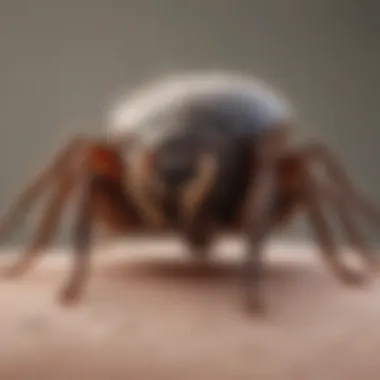

Methods for Control and Management
Controlling and managing sucking lice is essential not only for the health of hosts—both human and animal—but also for preventing the spread of lice-related diseases. Dealing with these pests is no walk in the park, particularly given their remarkable tenacity and adaptability. An understanding of and approach to effective management strategies can make a significant difference in outcomes, especially for schools, childcare facilities, and livestock operations.
The topic of control encompasses various strategies, and the blend of these methods is often what yields the best results. Strategies can be classified broadly into chemical and natural controls. Each has its advantages, considerations, and effectiveness on different types of lice populations.
Chemical Control Strategies
Chemical control methods have long been the go-to solution for managing sucking lice. These strategies primarily involve using topical insecticides and systemic treatments to eliminate lice. Products such as permethrin, pyrethroids, and malathion have emerged as common choices due to their effectiveness against adult lice and their eggs.
While these products can be powerful allies, their use warrants caution. Over-reliance on chemical pesticides can lead to resistance among lice populations. As lice evolve and adapt, the very substances designed to eliminate them may become less effective. This has sparked concern among health professionals and pest control experts, emphasizing the need for integrated pest management (IPM) strategies that not only rely on chemicals but also encompass various methods.
"In the quest for sustainable ecosystems, managing parasitic pests like sucking lice requires innovative solutions that reduce reliance on chemical interventions."
Understanding the timing of application can greatly impact effectiveness. For instance, treating during the nymphal stages is often more successful than targeting adult lice. Seasonal considerations also play a role; lice populations tend to surge during periods of close contact, such as winter months when people are indoors more frequently.
Natural and Organic Control Methods
On the flip side, natural and organic control methods present a compelling alternative for those concerned with the environmental impact of chemical treatments. These methods often utilize non-toxic substances or biological controls that disrupt the life cycle of lice without harming the host or surrounding environment.
Essential oils, such as tea tree, lavender, and neem oil, are known for their insecticidal properties. These oils can be mixed with carrier substances and applied to affected areas. For those choosing a natural route, it’s critical to ensure that the oils used are of high quality and applied correctly to maximize effectiveness.
Additionally, thorough cleaning of linens, garments, and living spaces is crucial. Lice can survive away from hosts for a limited time, so washing items in hot water and drying them at high temperatures can significantly impede their life cycle.
Considerations for Choosing Control Methods
- Effectiveness: Evaluate which method will best target the lice species present.
- Safety: Consider the safety of pets and children when selecting treatments.
- Resistance Management: Rotate between chemical and natural methods to prevent lice resistance.
Research Advances and Future Directions
In an ever-evolving landscape of parasitology, research into sucking lice has taken on an increasingly pivotal role. We're not just scratching the surface here; recent studies are peeling back layers of complexity, offering new insights that can help us understand these pests better. The advances in genomic studies, along with innovative treatment approaches, have opened doors that were once firmly shut. Such developments can lead not only to better management of infestations but also to groundbreaking understandings of host interactions and disease transmission.
Genomic Studies
Genomic research is turning the tide in how we conceptualize sucking lice. With the advent of advanced sequencing technology, scientists are now capable of deciphering the genetic blueprints of these parasites. Through these genomic studies, researchers have unearthed specific genes that are directly associated with the louse's feeding habits, resistance to treatments, and even its relationship with its hosts.
This research holds colossal importance for a couple of reasons:
- Targeted Treatments: By identifying genetic markers associated with resistance to common treatments, we can develop new strategies that specifically address these adaptations. This kind of precision medicine is invaluable for addressing therapy failures.
- Understanding Evolutionary Relationships: Genomics also allows us to trace the evolutionary pathways of sucking lice. It reveals not only how these insects have adapted to various hosts but also offers insights into the broader ecological roles they play.
In one study, researchers utilized genomic sequencing to identify how certain lice species develop resistance to traditional pesticides. Findings indicated that specific mutations in their DNA could lead to treatment failures. This kind of information is crucial for devising new strategies that can stave off lice proliferation effectively.
Innovative Treatment Approaches
While the use of chemical treatments has long been the go-to method for managing lice populations, there’s a growing movement towards exploring innovative treatment options. These approaches focus on sustainability and long-term efficacy rather than one-off solutions.
Some notable avenues being explored include:
- Biological Control: Using natural predators of lice, such as specific types of beetles or parasitic wasps, creates a balanced ecosystem where lice populations can be managed without chemical intervention.
- Gene Editing Techniques: Emerging techniques like CRISPR enable researchers to target and modify genes in lice, potentially making them easier to control in natural environments.
- Integrated Pest Management (IPM): This holistic approach combines traditional methods with environmental considerations and is built on understanding the life cycles and environmental factors affecting lice populations.
"By stepping away from purely chemical solutions, we may create strategies that not only manage lice effectively but also minimize the impact on non-target species and ecosystems."
Ultimately, as we closely examine and implement these advanced methods, we move toward a richer understanding of the broader implications of sucking lice in our environment. The pioneering work in this field is not just informative—it's an essential call to action for researchers, educators, and health professionals alike. Without a doubt, these advances may steer the future of louse management and contribute significantly to the health of both humans and animals.
Ending and Implications
The conclusion draws together the various strands discussed throughout this article, cementing the significance of understanding sucking lice. These creatures, while often overlooked due to their small size, play an outsized role in our ecosystems. The implications of their presence reach far beyond mere annoyance; they can affect both human and animal health in profound ways. Recognizing the complex interactions between sucking lice and their hosts, along with the diseases they transmit, underscores the necessity of further study.
In examining the life cycle and ecology of sucking lice, we realize their adaptability and resilience. This adaptability poses unique challenges in controlling their populations. Humans have historically faced difficulties in managing infestations, thus reaffirming the importance of continued research in control strategies—both chemical and organic. Over time, as genetic studies shed light on their resilient nature, our methods of treatment and prevention may become increasingly sophisticated. Adaptation is also a common theme among the lice themselves; they co-evolve with their hosts, highlighting a persistent arms race that deserves closer examination.
"Understanding the ecology and biology of sucking lice not only informs control measures but also provides insight into broader ecological dynamics."
In summary, the implications of this research extend to public health, veterinary medicine, and ecological studies. Addressing these topics ensures that future considerations include not only technical solutions but also an understanding of biodiversity and ecosystem health. As we strive to mitigate the effects of sucking lice in various species, the blend of practical management and biological insight remains paramount.
Summary of Key Findings
- Diverse Diversity: Sucking lice are not monolithic; they exhibit vast diversity across species, each with unique host preferences and ecological roles.
- Host Dependency: Their lifecycle intricately ties to the host’s biology and environment, which is crucial for understanding their impact.
- Disease Implications: Sucking lice are significant vectors for diseases, affecting both humans and animals, necessitating public health awareness.
- Control Challenges: Despite various control methods, challenges persist in effectively managing infestations due to their adaptability and co-evolution with hosts.
Importance for Future Research
The study of sucking lice is a call to arms for researchers in fields ranging from entomology to ecology.
- Evolving Methodologies: Future investigations should explore more sustainable and effective management practices, integrating both traditional and novel control measures.
- Understanding Resistance: Given their resilience, focused studies on biochemical resistance in sucking lice may provide insights leading to new treatments.
- Cross-Species Studies: There is a great opportunity to examine interactions between sucking lice and various host species to understand the impacts of climate change and anthropogenic effects on these relationships.
- Innovative Health Approaches: Collaborations between your average biologist and public health experts could foster innovative solutions to the diseases borne out of sucking lice, leading to more comprehensive management strategies.


